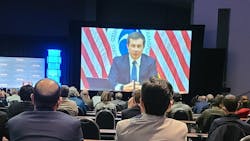Buttigieg touts infrastructure law, port efforts to unclog supply chain
WASHINGTON, D.C.—U.S. Transportation Secretary Pete Buttigieg paid the annual Transportation Research Board (TRB) meeting a brief visit via video on Jan. 12 to accept congratulations for the Infrastructure Investment and Jobs Act signed in November by President Biden and to tout what the law will do to create jobs, fight climate change, and help unclog the nation’s supply chain.
TRB leaders and industry professionals who gathered in the ballroom of the Walter E. Washington Convention Center greeted Buttigieg with applause several times during a 30-minute “fireside” chat moderated by Susan Shaheen, chair of TRB’s executive committee, and Nathaniel Ford, CEO of the Jacksonville (Florida) Transportation Authority.
See also: Numbers tell story of strained supply chain—but also of opportunities for trucking
“We are gathered in a different American moment,” Buttigieg said during his opening remarks, mentioning the COVID-19 pandemic, the climate crisis, and a nation divided politically and culturally in ways not seen since the Civil War. He notably at one pointed touted the infrastructure law as a jobs law: “Good transportation policy, directly and indirectly, creates jobs.”
He also mentioned several times how the new law would help bring jobs to underserved communities and businesses. According to the Biden administration, spending from the package could support more than 700,000 new jobs, including more than 100,000 new jobs in the transportation industry.
Buttigieg had visited the Ports of Los Angeles and Long Beach the day before, where he spoke about the $52 million earmarked for ports from the $1.2 trillion infrastructure law that will help the West Coast ports speed up the movement of goods via trucks and intermodal rail to terminals and warehouses on to store shelves and homes. He also mentioned how critical trucking is to the supply chain.
The $1.2 trillion legislation is the most significant infrastructure investment since the interstate highway system was created, which is why it was greeted by such fanfare during the TRB gathering of transportation researchers, engineers, and technologists.
The money will fix roads and bridges ($110 billion), build out electric vehicle charging—and other alternate fueling systems—as part of a nationwide infrastructure network ($7.5 billion), fund public transit ($49 billion), boost freight and passenger rail ($66 billion), improve airports ($25 billion), and boost broadband internet infrastructure ($65 billion).
Buttigieg during the TRB talk several times mentioned U.S. ports, which along with waterways will receive $16 billion under the new infrastructure law. The day before his chat to the conference, the transportation secretary visited the Ports of Los Angeles and Long Beach and credited $52 million in government investment for helping to speed the movement of goods at the West Coast ports.
At TRB, Buttigieg credited a new queuing system at the L.A. and Long Beach ports that is helping relieve containership congestion there and reduce pollution from idling ships. The new routine requires cargo vessels to arrive early and wait farther off the California coast, rather than packing within a 40-mile perimeter of the ports, which handle 40% of imports into the U.S.
Ford noted to Buttigieg the past year’s focus on congestion at the ports and in the supply chain and how the movement of imported goods had been slowed by inefficiency and labor shortages—some related to the COVID-19 pandemic—in freight warehouses, intermodal cargo transport, and in trucking, which one industry trade group estimates suffers from a driver shortage of 80,000 and growing.
“I want to make sure everyone understands that the sector is not handling less than it used to. Demand is at an all-time high,” Buttigieg noted to Ford and the TRB attendees. “Parts of the system aren’t talking to each other. This has to do partly [because of] labor issues. Some of these Issues built up long before the pandemic.”
He added later in the talk: “If anything healthy has come out of this, it’s the importance of our supply chain. If you got a gift under the tree [during the holidays], thank someone in the supply chain.”
TRB and other industry professionals have been pushing for highway and bridge improvements for decades. Nearly one of every five miles of U.S. highways and major roads are in poor condition, according to federal data. About 45,000 bridges are also rated poor.
The infrastructure law reauthorized surface transportation programs through 2026, replacing the Obama-era FAST Act. The law also sets aside up to $1 billion per year for "nationally significant freight and highway projects" through 2026. These special projects, which would be awarded regionally through DOT grants, include programs to generate national or regional economic benefits through reduced highway congestion, improved connectivity between freight transportation modes, and other projects that address the impacts of population growth on freight and people movement.
About the Author
Scott Achelpohl
Managing Editor
Scott Achelpohl is a former FleetOwner managing editor who wrote for the publication from 2021 to 2023. Since 2023, he has served as managing editor of Endeavor Business Media's Smart Industry, a FleetOwner affiliate.

